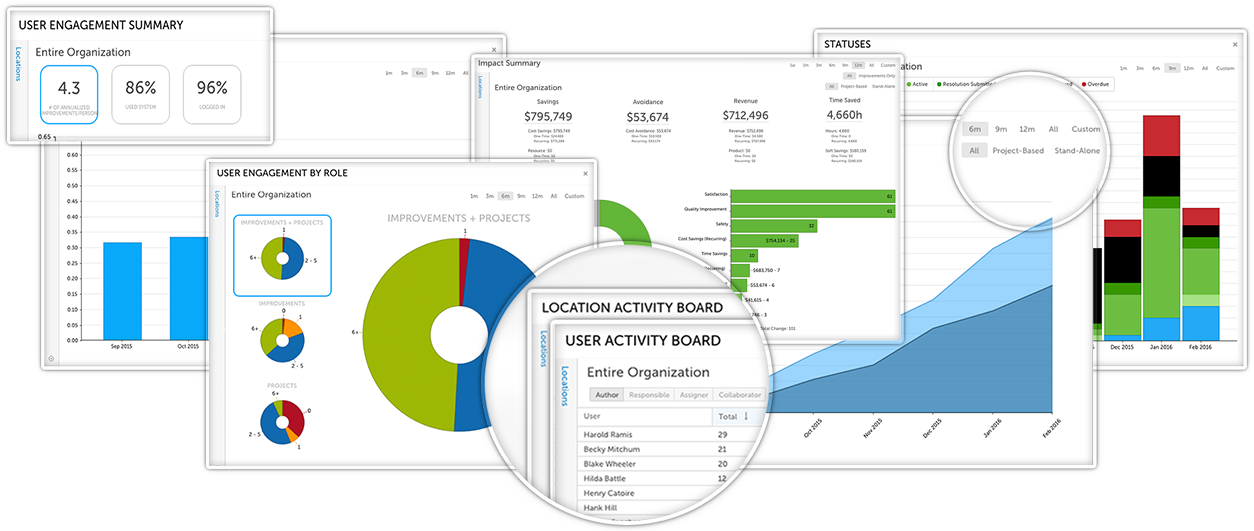 Organizations that strive to improve continually can stay ahead of the competition, regardless of their industry. From manufacturing and engineering to healthcare and education, the effort dedicated to consistent, positive change in an organization directly tied to sustainability and success.
Organizations that strive to improve continually can stay ahead of the competition, regardless of their industry. From manufacturing and engineering to healthcare and education, the effort dedicated to consistent, positive change in an organization directly tied to sustainability and success.
If you take a look at the measurements usually used to track an organization's success, you'll probably find a robust reporting framework in place. Financial metrics are probably the most obvious indicator of a company's health, and there isn't a company in the world that doesn't meticulously monitor them.
Tracking results toward financial other key performance indicators is worth doing only if you are using that data to adjust and improve processes across the organization. In this way, continuous improvement is an integral component of every metric that leaders care about.
Measuring, tracking, and reporting on improvement work is critical to ensuring that you meet your most important goals and out-innovate the competition.
Here's why it is so important.
Things That Get Measured Get Better
What we choose to measure says volumes about what leaders care about. In turn, employees respond by taking special effort to improve results that are being watched. Conversely, is something that isn't monitored, isn't viewed as a priority. You'll almost certainly see results get better when you start to track and report on metrics like the number of opportunities submitted, completed improvement projects, team engagement, time to completion, and so forth.

You'll Get a Better Understanding of the Truth
As a leader working to develop a culture of continuous improvement, you must set goals to drive progress. The exact nature of those goals varies, but generally, they revolve around engagement, activity, and impact.
When you think about an operational process, you likely think about the "current state" and the "desired state." That same thinking can be applied to improvement practices. Where does the organization sit today in terms of improvement work, and where would we like to take it? Data around improvement will help you answer both questions.
You Can Set SMART Goals
Many organizations fail to get specific when they discuss their plans for a robust approach to continuous improvement. For example, they may recognize that the current state has a low engagement rate and that their desired state is to have the whole company participating.
That's a good start, but it provides no useful data. Instead, successful organizations use the SMART goal setting strategy to drive their improvement culture. SMART goals are specific, measurable, agreed upon, realistic, and time-based.
To know whether you've achieved your goals, of course, you must have a way to track and report on activity, engagement, and impact.
Provide Better Support for Improvement Work
Making good decisions that promote the spread of continuous improvement requires insight. Having data about which areas of the organization are not performing well and having a standard, objective way to measure performance, lets you focus your coaching resources where needed for a higher ROI.
Knowing which variables result in high-impact improvements helps redirect energy to efforts that are likely to succeed. All decisions about improvement work should be made based on data for the best results.
Earn Additional Resources and Executive Support
Measuring the impact of continuous improvement efforts makes it a cinch to explain to executives how the work you're doing drives business success. When you supply objective data on how engagement and activity scores drive business impact, you validate the work that you're doing to spreading your improvement culture.
For example, if you can present unimpeachable data to show executives that the ROI for each person engaged in improvement work is more than $6,000 a year, you'll have an easy time justifying additional resources and investment.
The bottom line is that there are compelling reasons to apply the same careful measurement practices to improvement that you would for any other process. Doing so will help you make smarter decisions, increase engagement, and earn executive support.



Add a Comment